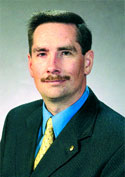
Features
Codes and standards
Hot topics
Major changes to NFPA codes approved by membership
In keeping with this edition's theme of fire prevention and public education, I thought it appropriate to give you a very brief update on the major changes recently approved by the NFPA membership at the World Safety Conference and Exposition, held in June.
December 19, 2007
By Sean Tracey
 In keeping with this edition's theme of fire prevention and public education, I thought it appropriate to give you a very brief update on the major changes recently approved by the NFPA membership at the World Safety Conference and Exposition, held in June. NFPA publishes a number of widely adopted code documents that are based on changes demanded by you, the fire service, and the general public. These latest changes highlight how effective the fire service can be through the NFPA standards development process in defining fire protection needs for our communities.
In keeping with this edition's theme of fire prevention and public education, I thought it appropriate to give you a very brief update on the major changes recently approved by the NFPA membership at the World Safety Conference and Exposition, held in June. NFPA publishes a number of widely adopted code documents that are based on changes demanded by you, the fire service, and the general public. These latest changes highlight how effective the fire service can be through the NFPA standards development process in defining fire protection needs for our communities.
On Feb. 20, 2003, 100 lives were lost and 200 persons were injured during the fire at the Station Nightclub. The fire broke out when the rock band Great White took the stage igniting pyrotechnics that subsequently started a fire. Following the fire, life safety advocates identified many changes for the NFPA 101 Life Safety Code, and NFPA 5000 Building Construction and Safety Code. These changes were initially identified as Tentative Interim Amendments, and included a minimum threshold for the sprinklering of existing occupancies and mandatory sprinklering of all new bars, and nightclubs. In June 2005, NFPA members voted to accept these changes into the 2006 editions of these codes. These changes were needed as a reminder that we as a society must always be vigilant against the risk of fire in assembly occupancies.
Another interesting development was that the NFPA membership passed the requirement for retroactive sprinklering of all nursing homes. The American Health Care Association, the member organization that represents the majority of the operators of these facilities, initiated the change proposal requiring retroactive sprinklering of this at risk occupancies. The International Fire Marshals Association also supported this. Again the NFPA members present voted to accept the requirement to retroactively sprinkler all these occupancies in the NFPA 101 Life Safety Code. Jurisdictions adopting this code will have a means to require the retroactive sprinklering of these vulnerable occupancies. In Canada, fires in nursing homes are three times more fatal than our national average, and six times more fatal than penitentiary fires. I believe a major factor for this is the lack of retrofit provisions in our current Canadian model codes.
Finally, and most significantly, the NFPA membership voted to support the introduction of mandatory sprinklering of all new one- and two-family dwellings in the 2006 editions of NFPA 101 Life Safety Code, and NFPA 5000 Building Construction and Safety Code. The International Association of Fire Chiefs championed this latest initiative. The NFPA Standards Council must still accept these changes. This represents a major change, as the NFPA codes will be the first major code set in North America to require residential sprinklers.
On the Canadian front, we are all awaiting the release of the new objective-based National Building and Fire Codes. These codes will also include many technical changes including updating of references to numerous NFPA standards. As your regional manager at NFPA, I will be investigating ways to provide education sessions on the impact of these to you in a timely manner. Changes include more extensive requirements for NFPA 25 in maintaining water-based systems, NFPA 33, etc.
The NFPA technical committee for the NFPA 1201 Standard for Providing Emergency Services to the Public, is looking into the development of models to determine staffing levels for fire inspectors, public safety educators, and fire investigators. This is intended to be annex material in the next edition of NFPA 1201. It will provide a framework for determining numbers of personnel in each of these expertise areas within communities. If you have any examples of models or wish to provide input into this effort please contact me.
All of the changes being put forward are part the ongoing effort by NFPA to produce codes and standards that reflect the values of our society and the needs of the fire service. These changes reflect our values and expectations. Finally, please remember that NFPA just publishes the standards. Individuals such as you write them. Your input is critical.
If you would like any further details on any of the above points, again please feel free to contact me.
Sean Tracey, P.Eng., is the Canadian regional manager of NFPA International and formerly the Canadian Armed Forces Fire Marshal. He may be reached at 613-830-9102, e-mail stracey@nfpa.org.
Print this page